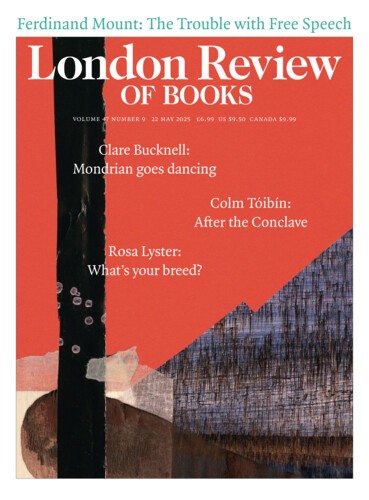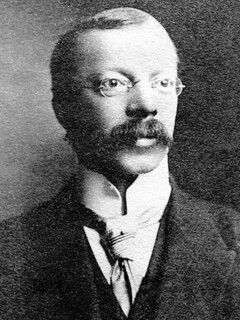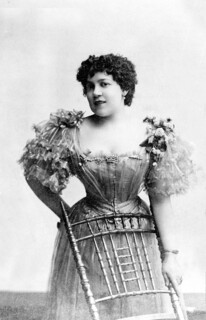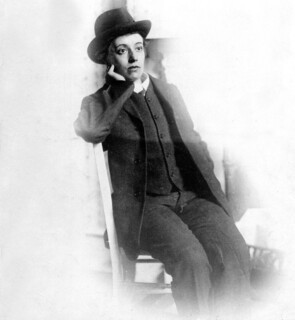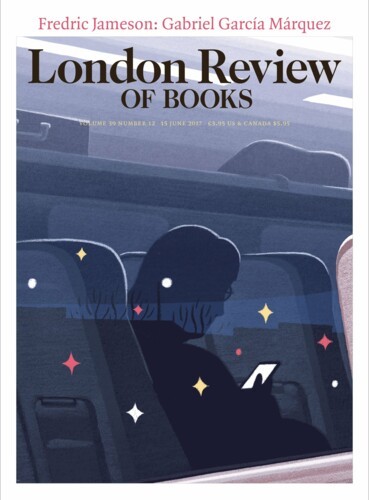Never trust a man who can’t settle, I thought to myself, as I was reading Hallie Rubenhold’s book. That was Hawley Harvey Crippen. No sooner had he found his feet in a new job than he was on the move again, whether out of eagerness, boredom, impatience or disillusionment, it’s impossible to know. Even reading about these moves is tiring. It must have been exhausting for Charlotte, his first wife, having to uproot herself every few months with their little son, Otto, as Crippen took a new post at another homeopathic or ophthalmic hospital. By the time of her death in 1892, at 33, her husband had abandoned jobs in Ohio, San Diego, Detroit, New York and Salt Lake City. He had also, thanks to his mentor Dr Phil Porter (‘one of homeopathy’s most pre-eminent specialists’), travelled to Berlin, Paris and London as a special correspondent for the American Homeopathic Journal of Obstetrics and Gynaecology. There’s another red flag: never trust a 19th-century male medic who is excessively interested in obs and gynae.
‘This is the story of a murder, not a murderer,’ Rubenhold writes in her prologue. She took the same approach in The Five (2019), her book about the women killed by Jack the Ripper, which concentrated on their lives before autumn 1888. Crippen may be the name forever associated with the ‘North London cellar murder’, but here he is treated by Rubenhold as one character in ‘an ensemble cast brought together to tell a more panoramic and human version of one of the most infamous crimes of the early 20th century’. Chiefly, she tells the life stories of three women who did trust Crippen, and faced the consequences.
Charlotte Bell was an Irish tenant farmer’s daughter who emigrated to New York in 1882 with her sister and mother after her father died of typhoid. In 1887, she became a trainee nurse at a homeopathic hospital on West 61st Street, which was looking for nurses to train and hire, as well as for medical interns. ‘Dr Crippen and Nurse Bell would have been thrown together in ward emergencies … They were married … the year that they met.’
Crippen was born in 1862 in Coldwater, Michigan, to Myron Crippen, a merchant, and his wife, Ardesee, a sewing-machine sales assistant. Myron, too, moved often: Florida, Canada, California. For a few years, the family disappears from the record. As a teenager, Crippen was apprenticed to a homeopathic doctor whose practice was on the ground floor of their apartment building in San José, and he went on to the University of Michigan, where he met Porter. By 1880, there were 56 new homeopathic hospitals in the US. They provided remedies that were ‘designed to assist a person’s “vital force” to heal the body’, and were thought to appeal particularly to women and the devout as ‘kinder’ and more ‘sympathetic’ cures for illness.
Sent to Europe to write articles for the American Homeopathic Journal, Crippen was soon developing ‘theories about disorders of the female reproductive system and their effects on other parts of the body … focusing on the ear.’ He seemed to have a weird fascination with and phobia about women’s reproductive systems. Rubenhold doesn’t theorise about this but simply tells the story as completely and accurately as possible. Crippen certainly didn’t want any more children. Charlotte’s brother, William, would later say that she’d written to her family before her death, from their new home in Salt Lake City, to tell them that Crippen was forcing her to have abortions. She had already submitted to ‘two dangerous cuttings’ when she wrote: ‘My husband is about to force me to the knife again … I want my relations to know that if I die it will be his fault.’
The official cause of her death was ‘paralysis of the sympathetic’, a homeopathic term implying a complete shutdown of the nervous system – in other words, a stroke. Had Crippen killed her? There was no such accusation. Charlotte was buried quietly in a pauper’s grave (Crippen had been disappointed to discover too late that her family were not wealthy aristocrats), and her death never investigated. Otto was brought up by his paternal grandparents, while Crippen ‘turned his sights east’.
Cora Turner, born Kunegunde Mackamotzki, and later to restyle herself as Belle Elmore, was the daughter of a hard-up German immigrant family in Brooklyn. She had an (illegal) abortion, aged eighteen, after her domestic employer got her pregnant. Dr George Clinton Jeffrey and Dr Crippen, his new assistant, recently arrived from Salt Lake City, carried it out. After a detailed sketch of the German immigrant community in Brooklyn (beer halls, German-language theatres, singing societies), Rubenhold forces us to watch this new romance develop, post-abortion, in the summer of 1892. We know, of course, that this same woman will, eighteen years later, lie filleted and boneless, her head and organs removed, under the cellar floor of 39 Hilldrop Crescent, just off Camden Road in North London.
Rubenhold’s explanation for Cora’s falling in love with Crippen is that she was a ‘fallen woman’, living alone in a rented room. The courtship would have been ‘an enjoyable distraction during the warmest part of the summer’, and she must have relished ‘sashaying down the boardwalks’ at Coney Island ‘on the linen-suited arm of an educated professional’. He wanted to marry her quickly, because he’d accepted a new job in Louisville, and so he rushed her off to Jersey City (the nearest Gretna Green). Needless to say, Crippen spent only a few months in Kentucky before he found a job in Missouri, and then, shortly after that, returned to New York. He’d ditched so many jobs by now that he was finding it hard to get another; instead, he was writing and editing articles for homeopathic journals.
Then Rubenhold writes ominously that ‘Crippen found himself in a predicament. Unless he was prepared to resort to drastic measures, the situation he wished most to avoid would become inevitable.’ In other words, Cora would get pregnant again. In the winter of 1894, aged 21, she had an oophorectomy, an operation described by some as amounting to the ‘castration of women’, which ‘immorally robbed them of their primary function in life, which was to bear children’.
Two previous accounts of the Crippen story leave out this operation. In his viscerally misogynistic introduction to the Notable British Trials volume on the case (1920), Filson Young doesn’t mention it at all, writing simply: ‘They had no children to complicate the relationship.’ In The Mild Murderer (1977), Tom Cullen writes: ‘Belle had not been long married before it became necessary to remove her ovaries … Even if they had adopted a child it might have made a difference, but they appeared set against this course.’ Not ‘they’, surely. Crippen was the one who did not want a child. ‘How Crippen’s young and fertile wife was persuaded that she required this form of intervention is unknown,’ Rubenhold writes. Crippen later claimed that Cora suffered from a prolapsed uterus and had painful periods, but Cora’s sister protested that she’d never said anything about this.
‘You know how I love babies,’ Cora wrote to her sister in 1909. ‘There is only one way to have a complete home, and that is to have a little child in it.’ The operation did not go smoothly. Rubenhold mentions discharge and a pus bag. Worse, it brought on an early menopause. Cora became ‘large’ and ‘opulent’, and in those days it was unacceptable for a married woman to be both childless and an ebullient, larger-than-life figure. Young describes her as ‘robust and animal’: ‘Her vitality was of that loud, aggressive and physical kind that seems to exhaust the atmosphere around it.’ It wasn’t just men who derided her for being large and loud. In The Girl who Loved Crippen (1957) the novelist Ursula Bloom claimed to be ‘disgusted’ by Cora’s ‘hysterical and blowsy’ appearance, while Dorothy L. Sayers summed her up in an article for the Sunday Times in 1934 as ‘noisy, over-vitalised, animal, seductive and intolerable’.
Cora initially wanted to train as an opera singer, but, when that didn’t work out, she decided instead to become a vaudeville performer, and took the name Belle Elmore. Young trashes her for this, too: ‘She had nothing but vanity, no scrap of the ability or industry necessary even for her small purposes.’ Apparently, she was ‘hissed off the stage’ in her music-hall appearances – a detail Rubenhold omits.
Crippen, meanwhile, was turning into a spiv. By early 1894, he had started working for James Monroe Munyon, a ‘professor’ – the title was his own – who made his fortune selling ‘Munyon’s Remedies’, which he advertised as ‘a cure for every disease’. Crippen was soon transferred to the head office in Philadelphia, where he was one of six ‘eminent specialists’ who looked down the throats, inside the ears and into the eyes of the gullible unwell. In 1897, he was tasked with opening a Munyon’s office in London.
Cue the third young woman of the story: Ethel Neave, later known as Ethel Le Neve, a sunny girl from Norfolk whose father had landed a job as a dairyman in Hampstead in 1890, and who trained to be a ‘lady typewriter’ at Pitman’s Metropolitan School in Bloomsbury. She met Crippen in 1902, by which time he was no longer at Munyon’s. (He had been fired when it was discovered that he was ‘moonlighting as his wife’s theatrical manager’.) After a short spell at the Sovereign Remedy Company – there is no end to the inventive names of these cure-all businesses – Crippen began working as a physician at the Drouet Institute for the Deaf, another fraudulent outfit where the hard of hearing were sent home with powder on the tongue, plasters behind the ears and ‘ear antiseptic’. Ethel’s sister, Nina, was the head of its ‘female typists department’, and got Ethel a job there. Inevitably, Crippen was soon visiting ‘his two teenaged typists at home’ and taking them for dinner at an Italian restaurant. When Nina married, his affair with Ethel began.
The Drouet Institute closed shortly after the journalist and Liberal MP Henry Labouchère denounced it in Truth magazine, calling it (in a subsequent libel case) ‘a disgraceful institution carried on for unworthy objects by discreditable means’. Crippen and his partners set up the Dean Drug Company in 1903, so that the institute could return to life under another name; after that it became the Aural Remedies Company. After this third incarnation collapsed, Crippen reinvented himself as Dr M. Franckel, the German manufacturer of a cure for deafness called Ohrsorb. He also started a dentistry company called the Yale Tooth Specialists (Ethel had twenty teeth extracted). By now, he and his partners were shameless swindlers.
One of the many features of Edwardian life that Rubenhold evokes brilliantly is the Music Hall Ladies’ Guild, an organisation set up in 1906 to raise funds for female music-hall performers who had fallen on hard times. Its headquarters were in Albion House in Holborn, where Crippen’s various businesses were also based. The guild became Belle’s lifeline. She was treasurer of its executive committee and threw herself into her duties, organising events such as the annual dinner of the Music Hall Artistes’ Railway Association. Her new friends were philanthropic thespians, including Melinda May, Lillian Nash, Paul and Clara Martinetti, Louise Smythson and Isabel Ginnett. They had all been famous music-hall performers in their time (Nash, whose stage name was Lil Hawthorne, and her sisters had dazzled audiences with ‘The Willow Pattern Plate’, ‘an ingenious piece of staging which featured a blue and white background designed as a china plate’, against which the women were camouflaged by their blue and white dresses).
Young lays into Belle for what he calls her ‘inordinate concupiscence’ as well as her vanity, extravagance and shrewishness. He claims she had an affair with Bruce Miller, another expat performer, famous – as Rubenhold intriguingly writes – for his ‘papier-mâché clockwork orchestra’. Miller later claimed that he never did more than kiss Belle and ‘could not be more than a friend’. Crippen kept reassuring Ethel that Belle would leave him and go back to the US with Miller, but nothing happened. Around 15 January 1910, he went to Lewis and Burrows, a chemist’s near his office in Holborn, and ordered five grains of hyoscine hydrobromide – an unusually large amount, usually only requested by hospitals – which he said was for homeopathic purposes. Two weeks later, the Crippens hosted a ‘potluck supper’ at 39 Hilldrop Crescent. Their guests, the Martinettis, were served several courses – soup followed by beef, salads, pudding, coffee and liqueurs – and were pressed to stay late into the night to play whist. Crippen had insisted they come to supper that evening, even though Paul Martinetti wasn’t feeling well. Leaving after midnight, the exhausted guests had trouble getting a taxi. Eventually they found a four-wheeler (‘a growler’).
Belle was never seen again. The guild received a letter a few days later, supposedly in her handwriting, saying she had been called to America at a few hours’ notice on family business and was resigning as treasurer. Nash and her husband, John, thought this was strange. They stopped by Hilldrop Crescent, but the windows were dark and no one answered the door. Why, the Martinettis asked Crippen, had Belle taken hardly any luggage with her, just one small basket? He said it was because she’d had to leave so suddenly. But then why, they wondered, hadn’t she sent them a postcard from the ship?
On 20 February, Crippen appeared at the Benevolent Fund Dinner and Ball at the Criterion with Ethel Le Neve – she had upgraded her surname – on his arm. She was wearing Belle’s ‘rising sun’ diamond brooch. The Music Hall Ladies were outraged. Crippen told them that Belle was dangerously ill with double pleuro-pneumonia, which she’d caught at sea. Later, he sent the Martinettis a message saying that she had died of pneumonia shortly after her ship docked. Highly suspicious, Louise Smythson visited Scotland Yard, but no one seemed interested. Smythson sent a committee member, Violet Bartram, to examine recent passenger lists on ships to the US. There was no mention of Belle’s name, and the Los Angeles Chamber of Commerce confirmed that ‘no one by the name of Crippen died during the month of March’. The story then begins to resemble Richard Osman’s We Solve Murders. These retired thespians wouldn’t let the matter rest. The Nashes went to Albion House to ask Crippen more questions. When he couldn’t produce the name of the crematorium to which Belle’s body had been consigned – or a death certificate – they rushed back to Scotland Yard. This time, they were listened to.
Meanwhile, Ethel had become the châtelaine of 39 Hilldrop Crescent, appropriating Belle’s furs and jewels. Two detectives called at the house: Detective Chief Inspector Walter Dew and Detective Sergeant Mitchell. Dew had been a young police officer in the Whitechapel division of the Metropolitan Police during the Jack the Ripper murders of the late 1880s (his memoir, I Caught Crippen, covers both cases). Crippen now changed his story, saying that as far as he knew Belle was still alive. He told the detectives about their marriage, explaining that his wife had been having an affair, and that they’d stopped sleeping together four years earlier. He was candid about his relationship with Ethel, who was now ‘living with him as his wife’.
Crippen had always been good at moving on swiftly, and that was exactly what he and Ethel did next. Crippen cut off her hair, she changed into a suit and put on a hat, and they left for France (although they first had to kill time ‘riding about East London on an omnibus’ after missing their train to Harwich). Dew and Mitchell returned to Hilldrop Crescent and started to dig in the garden and then in the coal cellar. There, buried in the earth under the brick floor, they found human remains: pieces of flesh, but no bones, head or sex organs. ‘The stench was unbearable,’ Dew wrote in I Caught Crippen (they had to ‘fortify themselves with brandy’ to keep digging). Traces of hyoscine were found in the remains, and there were a few other items buried with them, including part of a gentleman’s striped pyjama jacket that matched pyjamas found under Crippen’s bed. It seemed that Crippen had poisoned and then dismembered Belle. Nobody knows what he did with the missing body parts. Perhaps he burned them in the garden or threw them in the Regent’s Canal.
Crippen and Le Neve (still dressed as a boy) secured a cabin on HMS Montrose, which was bound for Montreal. Photographs of the couple were by now all over the international press. When the ship’s captain, Henry Kendall, glimpsed the older man surreptitiously squeezing the younger man’s hand, he felt it was his duty to investigate this act of possible homosexual ‘indecency’. While they were in the dining room, he slipped into their cabin, where he found a rag made from the sleeve of a woman’s under-bodice. It was being used to staunch menstrual blood.
The Montrose was one of only sixty ships in the world to have an onboard wireless set. Kendall managed to get a message to Inspector Dew: ‘Have strong suspicions that Crippen London cellar murderer and accomplice are among saloon passengers. Moustache taken off growing beard. Accomplice dressed as boy. Voice manner and build undoubtedly a girl. Both travelling as Mr and Master Robinson.’ A faster steamer, the Laurentic, sped across the Atlantic and overtook them. When the Montrose docked at its first port, Father Point in Quebec, Dew came on board disguised as a pilot. ‘Good morning, Dr Crippen,’ he said, and put him in handcuffs. Both Crippen and Le Neve were charged: he with murder and mutilation, she with murder and ‘receiving, comforting, harbouring and assisting Hawley Harvey Crippen’.
It took the jury at the Old Bailey just 27 minutes to find Crippen guilty and 20 minutes for another jury, in a separate trial, to acquit Ethel. Crippen protested his innocence until his dying day – which soon came. He was hanged in Pentonville Prison on 23 November 1910. Le Neve ended up as a housewife and mother in Croydon, where she lived until her death in 1967, spending her evenings doing crochet and suffering from occasional bouts of paranoia.
In his essay for Notable British Trials, Young refers to the extremes of good and evil, writing that ‘somewhere between these extremes, far below the highest, but far above the lowest, lies the case of Dr Crippen, who killed his wife in order to give his life to the woman he loved.’ ‘There are two sides to the story,’ he continues, ‘the physical, which is sordid, dreadful and revolting, and the spiritual, which is good and heroic.’ Rubenhold is having none of that. On the eve of his hanging, Crippen wrote a sentimental final message to Le Neve, declaring his eternal love and gratitude. ‘And with that, the swindling, duping, lying Crippen, a confidence trickster to the very end of his life, makes the now damp-eyed reader forget in an instant that he is a murderer, condemned to death for ruthlessly killing his spouse.’
Rubenhold feels bound to mention the awkward detail that in 2008, during the production of an American TV programme called Secrets of the Dead, a sample of Belle’s skin was sent to a lab at Michigan State University to be tested. The mitochondrial DNA reading did not match that of Belle’s living relatives. What’s more, a new test for determining sex was carried out, revealing that the remains in the cellar were in fact male. In which case, the whole story implodes. But Professor Turi King, a member of the team who identified the remains of Richard III in 2012, is unconvinced by those Michigan findings, and does not believe that a case for Crippen’s innocence has been made.
Send Letters To:
The Editor
London Review of Books,
28 Little Russell Street
London, WC1A 2HN
letters@lrb.co.uk
Please include name, address, and a telephone number.
